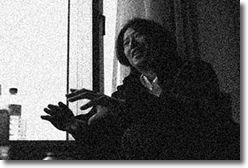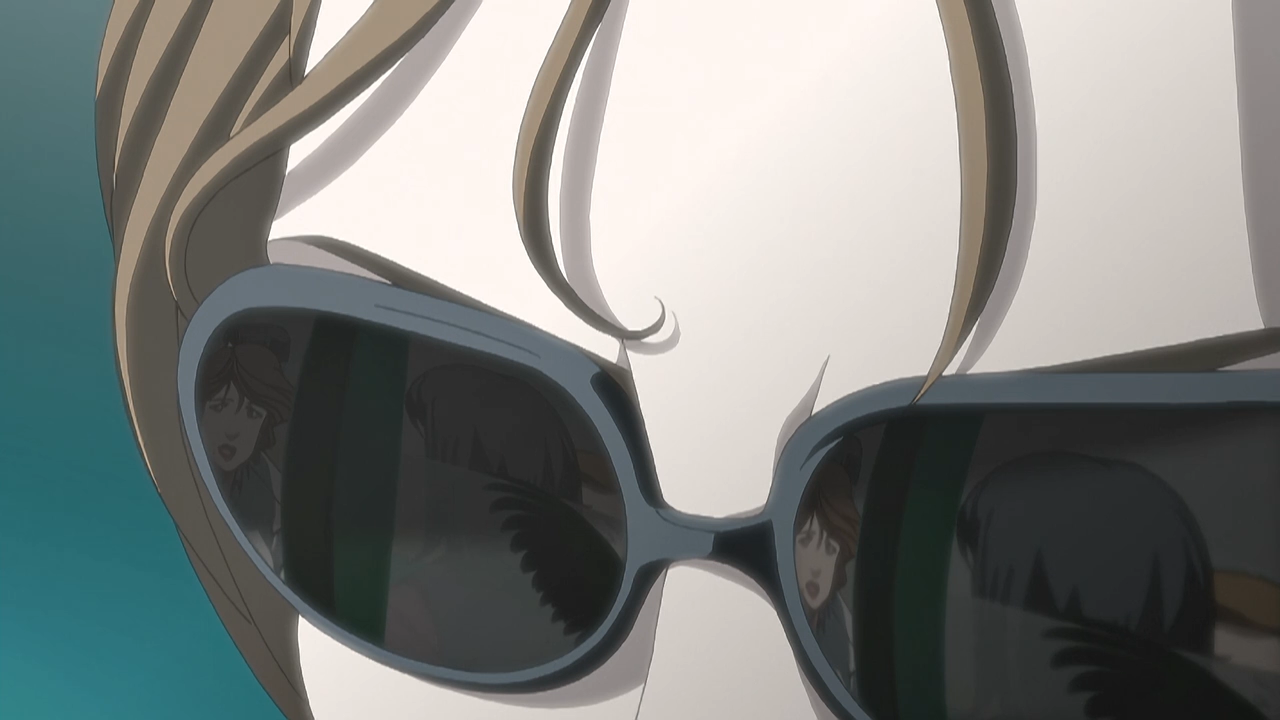 The following interview was originally posted on WEB Anime Style on February 14th, 2005. The interview has been translated by Twitter user @frog_kun © 2017 Wave Motion Cannon
The following interview was originally posted on WEB Anime Style on February 14th, 2005. The interview has been translated by Twitter user @frog_kun © 2017 Wave Motion Cannon
Want to see more content like this? Consider supporting us on Patreon!
The following interview is the second in a three part interview with Akiyuki Shinbo by Yuichiro Oguro. Shinbo goes into the details of Le Portrait de Petit Cossette, and mentioned the original intention of a sequel TV series. Be sure to read Part 1!
 Oguro: The artwork was also very interesting this time around. Like the in-show posters and so forth.
Oguro: The artwork was also very interesting this time around. Like the in-show posters and so forth.
Shinbo: Ahh, that was Okama-san’s doing.
Oguro: All the posters were drawn by Okama-san?
Shinbo: Yep.
Oguro: In the opening of episode 1, there’s a cut that dramatically reveals the posters stuck to the wall. That looked quite cool.
Shinbo: The opening took on that form after Okama-san’s drawings came in. In the initial storyboards, it was just going to open with a normal scene of the protagonist going to his part-time job at the antique store. When I saw the posters and heard the main theme, that opening came to me.
Oguro: The typefacing of the title was also nice.
Shinbo: Yeah. Those were some really cool-looking letters.
Oguro: Who drew them, may I ask?
Fujimoto: The person who handles all the packaging for Cossette—the designer Akiko Yoshimura.
Shinbo: Yep. She did well.
Oguro: The credit for the art director was strange. If I recall correctly, it was Easter Princess Group.
Shinbo: Hey, what group was it called again? I get the feeling I said, “Do what you want.” (laughs)
Oguro: This is getting a bit off-topic, but is that the name of a team within Studio Easter?
Shinbo: Yeah. For a while, The art directors at Studio Easter wouldn’t use their names, both with this project and others. They would go by the name of [insert name] Group instead, apparently. Lately, it seems they’ve been going by their individual names again, though. Broadly speaking, the art direction of Cossette’s first episode was handled by Jun’ichi Higashi-san and Hisaharu Iijima-san. Higashi-san has been doing these things for me since Tenamonya Voyagers, so it’s been quite a long time. That’s why I came up with ideas based on Higashi-san’s art when I was creating Cossette, too.
Oguro: What do you like about Higashi-san’s art?
Shinbo: Higashi-san can change direction depending on the anime. When you’re always making anime like I am, you’d want an artist who can draw backgrounds that fit the anime in question. Higashi-san is someone who can do that. That’s what I like about him.
Oguro: Why did you choose the ‘eye’ motif for the posters?
Shinbo: Why did I do that again…? Oh right, I wanted to convey an image of being ‘watched’. The protagonist watches the girl through the glass, but it actually feels more like he’s the one being watched, don’t you think?


▲ These posters designed by Okama appear in Le Portrait de Petite Cossette.
Oguro: I see. Earlier, you mentioned that the animation director Suzuki-san played a large role, but what exactly did he do?
Shinbo: The layouts.
Oguro: For all three episodes?
Shinbo: Yep. Especially with episode 1.
Oguro: Shinbo-san, your visuals are so offbeat. So Suzuki-san came on board for those parts?
Shinbo: He sure did. That’s why I’m grateful to him.
Oguro: Come to think of it, there were some scenes where Suzuki-san even did the compositing (TL note: satsuei).
Shinbo: If we’re talking about episode 1, that psychic surgery scene at the end was entirely Suzuki-san’s doing. (Editor’s note: The climax of episode 1. There is a sequence where the container cursed with Cossette’s soul is yanked out of the protagonist Eiri’s body after he has transformed into a monster. Suzuki-san handled the compositing of almost 40 cuts.)
Oguro: Was Suzuki-san also looking at the colors there?
Shinbo: Yeah. He was adjusting the colors too. We were always having discussions about the color coordination.
Oguro: Was Suzuki-san looking at the colors for other scenes as well? That’s rare for an animation director’s job.
Shinbo: But I think that an animation director should appear at the meetings dedicated to the background artwork (TL note: bijutsu), and that they should also look at the colors. If they don’t do that, they won’t be able to apply the shades, even when they’re only doing it in one particular way. As they draw, they should be thinking, “The colors will be applied to show this level of contrast, so I’ll only use this amount of shade.” At least, that’s what I think.
Oguro: So Suzuki-san also attended the meetings dedicated to the coloring, huh?
Shinbo: Yeah. Suzuki-san and I participate when the color coordinator decides the color scheme. We say things like, “We’re going to put this amount of shade in, so this amount of color is okay,” or “Could you please tone down the colors a bit more?” I believe that’s how things were originally supposed to be done when it comes to anime.
Oguro: But you can’t do things that way with TV anime.
Shinbo: Yeah, it’s impossible with TV anime. In order to do it, we took longer with Cossette than we expected. That’s undeniable. Also, the color coordinator was very skilled, so that helped us out. Her name was Keiko Shibuya-san. Apparently, she’s always been a big fan of Cossette’s kind of setting.
Oguro: She decided all the colors in the anime?
Shinbo: She did. Because we had a lot of time with episode 1 in particular, Shibuya-san’s eye for detail came to the fore. She would examine each cut one by one and say, “I want to do it a bit like this.” Normally, you just can’t this much done for you. So if you’re going to praise the final product, that wasn’t my doing; it was all because of the wonderful staff around me. I was just watching them, with absolutely nothing to say. (laughs)
Oguro: You’re just being modest.
Shinbo: Suzuki-san also relied heavily on Shibuya-san. During color coordination, she often did the work that we’d normally be doing just before the cuts and backgrounds are sent off for compositing. (TL note: He’s talking about satsudashi, the final checks an episode director performs just before the compositing.) “In this cut, the characters and backgrounds should be like this, so let’s downplay the color gradations of the characters a tad,” things like that. She even worked on the finer details.
Oguro: Where do you normally decide how to handle the compositing?
Shinbo: We usually decided things like the direction of the lighting or where to put the shadows at the meetings dedicated to the coloring. We do it together as a group. That’s how we proceeded when working on episode 1. After that, everyone got used to it, and from then on, I’d only ask things like, “Okay, so it generally goes like this. Can I leave it to you?” Everybody worked so hard on this anime with minimal input from my end; I really hope more people will watch it.



▲ From Le Portrait de Petite Cossette. Aside from Cossette, the anime features numerous female characters with unique traits.
Oguro: Let’s talk about the story. As you were making the anime, how much did you think the audience would understand? (laughs)
Shinbo: Hmm, that’s hard to say. Even as I was making it, I thought, “They probably won’t understand.” I do sort of think we should have made it a teensy bit easier to understand. (chuckles wryly)
Oguro: It’s not the kind of anime that spoon feeds everything to you.
Shinbo: Yeah. That’s why you can watch it attentively or casually. Perhaps Cossette has turned out to be the kind of anime you can watch in either fashion.
Oguro: No, if you watch it casually, you’ll just get more and more confused. It’ll be over before you realize what’s going on. (laughs)
Shinbo: (laughs) I wonder about that. You can watch a good chunk of it just for the music, I think. I guess I’m fine with people watching the anime like a music clip. I also get the feeling that if the story is too easy to understand, that’s where they’ll stop. (laughs) My desire to make something that you could watch multiple times was certainly a factor. I suppose that’s one of the differences between a TV and video release.
Oguro: In that sense, this original video feels very much like an original video, which is unusual these days.
Shinbo: They’ve been practically nonexistent recently. Anyway, to go on with what I was saying, when you’re watching something on TV you have the freedom to change channels halfway through, but when it comes to videos, you have to consciously buy or borrow it before you can watch it. I thought it would be nice to create something for that kind of audience. But if the content is too heavy, they won’t feel like watching it, huh? (laughs)
Oguro: Indeed. But don’t you think the content in this anime was rather heavy?
Shinbo: Hmm, I wonder about that. I have no way of knowing myself. I get the feeling that it’s kind of long. (laughs)
Oguro: A lot of people will be watching the anime after this, so I don’t think we can talk much about the latter half of the story, but it’s evident that the Cossette whom the protagonist encounters is not the real Cossette. Where did the fake Cossette come in?
Shinbo: From the part where [Removed by the editor’s decision].
Oguro: Ah, so until then, it was the real Cossette?
Shinbo: Yep.
Oguro: So when was the moment she turned into a fake?
Shinbo: It says in Cossette’s narration that [removed]. And then she was put into the [removed]. That’s when the real Cossette disappears.
Oguro: Oh, I see.
Shinbo: And thus, everything you see of Cossette after that is a different Cossette. Right until the very end, when she opens her eyes, the real Cossette is simply snoozing. (laughs)
Oguro: Ah, so when she opens her eyes at the very end, that’s the real her.
Shinbo: The genuine article. And that’s why the Cossette inside the [removed] is the real one.
Oguro: Ahhh. And here I thought you were ending it on a horror story-like cliffhanger. (laughs)
Shinbo: When Eiri arrived at the place where Cossette was, Cossette’s eyes opened. I was going for a Sleeping Beauty sort of vibe. The prince makes her eyes open—that kind of thing. (laughs)
Oguro: There’s a slew of female characters who aren’t mentioned in the plot summary. Why was the cast made up that way?
Shinbo: Hmm, I guess that’s what the scriptwriter likes. (laughs) I think.
Oguro: The story in this anime is like the setup of a harem anime.
Shinbo: Yeah. But I wonder if that was intended at all?
Fujimoto: It was, somewhat. If it were turned into a TV series…
Shinbo: Yeah. There was some desire to make a TV series.
Oguro: So my hunch was right, huh? At what stage of the development was this?
Shinbo: From the very beginning. It was Mayori Sekijima-san’s job to make those characters. If it were a TV series, they would have a bit more to do. (laughs)
Oguro: The love interest Shoko was in love with the protagonist before the plot began?
Shinbo: Seems like it. (laughs) Not that I had anything to do with it, probably.
Oguro: “Nothing to do with it,” you say? (laughs)
Shinbo: When you put it that way, it sounds weird. I was like, “Guess that’s how it is,” and didn’t particularly bother about confirming it all with Sekijima-san. I figured he must really like that trope.
Oguro: (laughs)
Shinbo: That’s why I want to use the other characters and make another story. I get the feeling I could do a lot of things with them. Like the lady from the croquette vendor next door.
Oguro: The girl from the delicatessen was a bit of fresh air.
Shinbo: Yeah. I always said as a joke: “She’d invent all sorts of side dishes and make the protagonist eat them.”
Fujimoto: And she has the ability to sense the supernatural to boot.
Shinbo: The ‘Otherworldly Croquette Vendor.’ (laughs) I want to make an original anime where the protagonist undergoes various transformations every episode after eating those croquettes. And then all sorts of incidents happen.
Fujimoto: That’s the first I’ve heard of that story. (laughs)
Shinbo: It’s like Popeye. Instead of spinach, eating side dishes powers him up.
Oguro: Was there really going to be a Cossette TV series?
Shinbo: I had a strong desire to do it.
Oguro: Even now?
Shinbo: Yep.
Oguro: It starts in the same way and then veers off into a different direction. Was that how it was going to be?
Shinbo: Er…
Oguro: Would it be a different anime with the same characters?
Shinbo: No, I mean, it could be a continuation of the story.
Oguro: Say what?
Shinbo: We could make a different anime altogether, too. We’re considering both options.
Oguro: No matter how you spin it, that couldn’t be the continuation. The characters have already been through a life-or-death situation. I can’t see how they could return to a normal life after that.
Shinbo: Well, it might be quite difficult to resume an ordinary life.
Fujimoto: Weren’t we going to change the flavor of the story? Well, the OVA was terribly serious, so people were saying we should make a comedy sequel, or something along those lines. They said we should do something similar to SoulTaker. (laughs)
Shinbo: Then would the title be Cossette-san?
Fujimoto: Sure, let’s go with that. (laughs)
Shinbo: She comes in from a comet somewhere.
Oguro: She’d be the princess from outer space.
Fujimoto: She’s a witch girl, I tell you. A witch.
Shinbo: If we’re making a sequel, then it would be Cossette-san? Is that right? (laughs)


3 Pingbacks